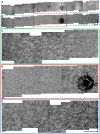Choriocapillaris and choroidal microvasculature imaging with ultrahigh speed OCT angiography
- PMID: 24349078
- PMCID: PMC3859478
- DOI: 10.1371/journal.pone.0081499
Choriocapillaris and choroidal microvasculature imaging with ultrahigh speed OCT angiography
Abstract
We demonstrate in vivo choriocapillaris and choroidal microvasculature imaging in normal human subjects using optical coherence tomography (OCT). An ultrahigh speed swept source OCT prototype at 1060 nm wavelengths with a 400 kHz A-scan rate is developed for three-dimensional ultrahigh speed imaging of the posterior eye. OCT angiography is used to image three-dimensional vascular structure without the need for exogenous fluorophores by detecting erythrocyte motion contrast between OCT intensity cross-sectional images acquired rapidly and repeatedly from the same location on the retina. En face OCT angiograms of the choriocapillaris and choroidal vasculature are visualized by acquiring cross-sectional OCT angiograms volumetrically via raster scanning and segmenting the three-dimensional angiographic data at multiple depths below the retinal pigment epithelium (RPE). Fine microvasculature of the choriocapillaris, as well as tightly packed networks of feeding arterioles and draining venules, can be visualized at different en face depths. Panoramic ultra-wide field stitched OCT angiograms of the choriocapillaris spanning ∼32 mm on the retina show distinct vascular structures at different fundus locations. Isolated smaller fields at the central fovea and ∼6 mm nasal to the fovea at the depths of the choriocapillaris and Sattler's layer show vasculature structures consistent with established architectural morphology from histological and electron micrograph corrosion casting studies. Choriocapillaris imaging was performed in eight healthy volunteers with OCT angiograms successfully acquired from all subjects. These results demonstrate the feasibility of ultrahigh speed OCT for in vivo dye-free choriocapillaris and choroidal vasculature imaging, in addition to conventional structural imaging.
Conflict of interest statement
Figures






References
-
- Schmetterer L, Kiel JW (2012) Ocular Blood Flow. Springer Berlin Heidelberg.
-
- Lutty G, Grunwald J, Majji AB, Uyama M, Yoneya S (1999) Changes in choriocapillaris and retinal pigment epithelium in age-related macular degeneration. Mol Vis 5: 35. - PubMed
-
- Cao J, McLeod S, Merges CA, Lutty GA (1998) Choriocapillaris degeneration and related pathologic changes in human diabetic eyes. Arch Ophthalmol 116: 589–597. - PubMed
-
- von Sallmann L (1961) The structure of the eye. Arch Ophthalmol 66: 920–921.
-
- Sarks JP, Sarks SH, Killingsworth MC (1988) Evolution of Geographic Atrophy of the Retinal-Pigment Epithelium. Eye 2: 552–577. - PubMed
Publication types
MeSH terms
Grants and funding
LinkOut - more resources
Full Text Sources
Other Literature Sources
Medical
Research Materials

